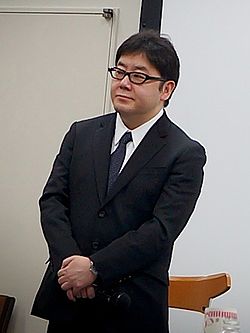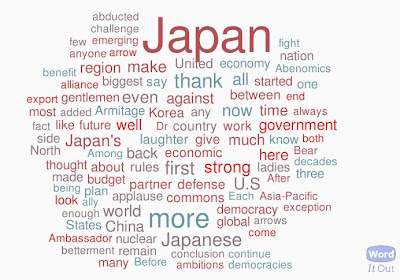This is one of the very few times I've ever heard of the name of a worker who has worked at Fukushima I Nuclear Power Plant since the start of the accident on March 11, 2011.
Hardly anyone in Japan wants to know about them, for one reason ("We hate them because they work for TEPCO" kind of reason) or another ("I'm sure they want to be left alone" kind of PC reason). But that doesn't stop foreign journalists, and as has been the case since the start of the nuclear accident, they are good at bringing the personal stories out of the huge, inhuman mess of an accident.
I believe Mr. McNeill is based in Tokyo.
I'd love to read the article, but for some reason the Independent site seems to believe I have used up the free 5 page allowance for the month even though I never visited their site in a month until today and won't let me read.
You can try if you have better luck, here: http://www.independent.co.uk/news/world/asia/i-am-one-of-the-fukushima-fifty-one-of-the-men-who-risked-their-lives-to-prevent-a-catastrophe-shares-his-story-8517394.html
(H/T blog reader wren for the link)
====================================
(UPDATE: The actual article)
'I am one of the Fukushima fifty': One of the men who risked their lives to prevent a catastrophe shares his story
They displayed a bravery few can comprehend, yet very little is known about the men who stayed behind to save Japan’s stricken nuclear plant. In a rare interview, David McNeill meets Atsufumi Yoshizawa, who was at work on 11 March 2011 when disaster struck
David McNeill, Saturday 02 March 2013
It was, recalls Atsufumi Yoshizawa, a suicide mission: volunteering to return to a dangerously radioactive nuclear power plant on the verge of tipping out of control.
As he said goodbye to his colleagues they saluted him, like soldiers in battle. The wartime analogies were hard to avoid: in the international media he was a kamikaze, a samurai or simply one of the heroic Fukushima 50. The descriptions still embarrass him. “I’m not a hero,” he says. “I was just trying to do my job.”
A stoic, soft-spoken man dressed in the blue utility suit of his embattled employer Tokyo Electric Power Co., (Tepco) Mr Yoshizawa still finds it hard to dredge up memories of fighting to stop catastrophe at the Fukushima Daiichi plant. Two years later, debate still rages about responsibility for the planet’s worst nuclear disaster since Chernobyl, and its impact. Fish caught near the plant this month contained over 5,000 times safe radiation limits, according to state broadcaster NHK.
A report this week by the World Health Organisation says female infants affected by the worst of the fallout have a 70 per cent higher risk of developing thyroid cancer over their lifetimes, but concluded that overall risks for the rest of the population are “low”. Over 160,000 people have been displaced from their homes near the plant, perhaps permanently, and are fighting for proper compensation. Stress, divorce and suicides and plague the evacuees.
Mr Yoshizawa says he feels “deep responsibility” for the crisis his company triggered. His eyes brim with tears at points in his story, which begins with the magnitude-9 quake less than 100 miles away from the plant under the sea on 11 March 2011. “It was so strong I fell on my hands and knees,” says the 54-year-old engineer. “There was no place to hide.”
The quake’s shockwaves ripped pipes from walls, bounced parked cars like toys and buckled roads at the 864-acre plant. Initially, Mr Yoshizawa believed the Daiichi’s defensive engineering had worked. The instant the tremors struck, control rods were automatically inserted into the plant’s three working reactors to shut down nuclear fission, a process known as “scram.” But the shaking had cut power from the main electricity grid, probably damaged the cooling system to reactor one, and a destructive tsunami over twice as high as the plant’s defences was just 49 minutes away.
Mr Yoshizawa was in charge of reactors five and six, which at the time were shut down for maintenance. He ran to the plant’s seismic isolation building and took his post beside manager Masao Yoshida, who was trying to assess the damage. In the windowless bunker they couldn’t see the tsunami that hit the complex. Waves of 13 to 15 metres high washed over the 5.7m sea wall. Water flooded the basements of the turbine buildings, on the ocean side of the reactors, shorting out electric switching units and disabling 12 of the 13 emergency generators and then backup batteries, the last line of defence. There was no power to pump water to the nuclear core and carry off the heat, or even measure the radiation. The engineers had lost control over the complex. Meltdown had begun.
Mr Yoshiizawa recalls hearing the first reports inside the bunker of oil tanks and cars floating in water outside. “I just couldn’t imagine a tsunami that big,” he says. The crisis quickly deepened. Just over 15 hours after the power loss, uranium fuel melted through the pressure vessel of reactor number one. Units two and three were not far behind. Thousands fled from nearby towns and villages. There was no plan for what to do next because Tepco had never predicted total loss of power at a plant.
Most of Daiichi’s employees had gone home to check on their families. Mr Yoshizawa says he thought of two things: “The safety of my workers, and the complete shutdown of the power plant.” His own wife and two daughters were safe in Yokohama, hundreds of miles south. There was no question of panic, or running back to see them, he insists. “It might seem strange to others, but it’s natural for us to put our company first. It’s part of the mind and spirit of Tepco workers to deal with emergencies.”
The engineer says he moved offsite for a few days to a disaster-response building in the town of Okuma, 5 km away. But on 15 and 16 March 2011 the situation at Daiichi reached its most critical phase. A series of hydrogen explosions had left much of the complex a tangled mess of radioactive concrete and steel. Unit three had exploded, three reactors were in meltdown and over 1000 fuel rods in the reactor four building, normally covered under 16 feet of water, had boiled dry, raising the spectre of a nuclear fission chain reaction. In his darkest moments, Mr Yoshizawa admits he shared the same fear as other experts – that the crisis could also trigger the evacuation of the Fukushima Daini plant 10 km away.
About 250 km south in Tokyo, the government feared a nightmare scenario: a vast toxic cloud heading toward the world’s most populated metropolis. Rumours swirled that Tepco was preparing to completely pull out its staff from the Daiichi plant, leaving it to spin out of control. Mr Yoshizawa denies this. “We never intended to abandon our jobs,” he insists. “At the time that rumour was circulating I was volunteering to go back.” He recalls despairing at the situation. “Most people thought we would not be coming back from the plant,” he says, on the verge of tears. In the media the Fukushima 50 was born, although Mr Yoshizawa says that in reality there were 70 of them, mostly in their middle age. “We had all resolved to stay till the end.”
Throughout the following weeks on the frontline of the crisis, the men endured brutal conditions. Deliveries stalled, food almost ran out and water was restricted to a single 500ml bottle every two days. Working in shifts, surviving on biscuits and sleeping when he could inside the radiation-proofed bunker, Mr Yoshizawa lost weight and grew a beard. As elite firefighters succeeded in getting water to the overheating reactors, the collective psyche inside the bunker lightened and the dreaded words “oshimai da” (it’s the end), were no longer heard. Exhausted and dishevelled on his first trip back to a sunny Tokyo a month after the quake, he was startled to find life going on as normal.
Public recognition or even gratitude for the ordeal endured by Mr Yoshizawa and his colleagues is scarce. Most are still employed by a company disgraced by revelations that it had repeatedly ignored pre-March 11 warnings about the risks of natural disaster. Taxpayers will have to bear the cost of cleaning up from the accident after Tepco was nationalised last year. Not a single manager has been held accountable for happened. The utility’s rehabilitation has been hampered by fresh stories that it had misled investigators before an on-site check of reactor one, lying that the reactor building was “too dark” for inspection. Some critics suspect the company was trying to conceal evidence of damage from the earthquake, an issue with potentially profound implications for restarting Japan’s 50 commercial reactors, most of which are shut down.
It took the government 18 months to publicly acknowledge Mr Yoshizawa and his comrades, when then Prime Minister Yoshihiko Noda officially thanked them last October. Most were not identified or even named, testimony both to the trauma Fukushima has inflicted on Japan’s collective psyche, and a deep-seated cultural reluctance to grandstand while others suffer. Some of the men fear reprisals or bullying of their children in school. A police van is permanently parked out the company’s headquarters in Tokyo. Tepco itself is reluctant to wheel the Fukushima 50 out in front of the media, for fear of what they might reveal about what happened – Mr Yoshizawa is shadowed throughout his interviews by a PR minder.
But if he nurses any bitterness toward his employer, he never reveals it. He praises the company for providing counseling to the ex-Daiichi workers and regular health checks – a select list of employees who absorbed potentially harmful amounts of radiation are qualified for unlimited aftercare. His own final tally of internal exposure was 50 millisieverts – the upper annual limit in the US for nuclear plant workers.
Now dealing with waste and fuel management, and back at Tepco headquarters, he says the work at the plant has far from ended. “Nobody has any experience of trying to safely extract nuclear fuel after such an accident,” he says. British and US engineers are helping in a collective effort that will take many years. He gets uncomfortable when he returns to Fukushima and has to remember the crisis. His family never discusses what happened. “My wife and children have already seen so much on TV and they don’t want to see or hear anything more about it. Occasionally they will ask me if I’m OK and I tell them what I tell you: I don’t have any problems.”
Living in limbo: refugees’ grievances
Two years on, thousands of people forced to leave their homes in the wake of the Fukushima disaster are living in limbo, yet to receive compensation and unable to move back owing to dangerous radiation.
More than 160,000 people were forcibly evacuated from the area when an earthquake and tsunami crippled the Fukushima Daiichi nuclear plant on 11 March 2011, and tens of thousands left voluntarily.
Tokyo Electric Power (Tepco), the company that owns the plant, has paid compensation to some nuclear refugees, including what it calls “temporary” compensation for living costs, but it has paid no money for assets damaged by the meltdown.
A recent report by Greenpeace documented a litany of complaints about complicated forms, insufficient living costs and low valuations on property. Greenpeace said the plan was drawn up by Tepco in July last year and is based on a “complex and disputed” government system.
(H/T blog readers NYUltraBuddha, prestant)
=======================
(UPDATE 3/4/2013) There is absolutely no coverage in Japan that Mr. Yoshizawa, TEPCO's senior manager, was interviewed by foreign press (The Independent, The Guardian).












.jpg)









 Tokyo Time
Tokyo Time
![[Most Recent Quotes from www.kitco.com]](http://www.kitconet.com/charts/metals/gold/t24_au_en_usoz_2.gif)

